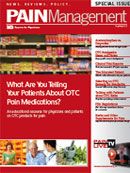Publication
Article
Pain Management
Talking with Patients about Risks associated with OTC Pain Relievers
Brief overviews of commonly asked questions regarding OTC acetaminophen and ibuprofen, and key messages for patients.
Brief overviews of commonly asked questions regarding OTC acetaminophen and ibuprofen:
Acetaminophen is “the most widely used pharmaceutical analgesic and antipyretic agent” in the US. Overdosing on acetaminophen can cause liver damage and, in more severe cases, even liver failure and death. In fact, in the US “acetaminophen toxicity has not only replaced viral hepatitis as the most common cause of acute hepatic failure, but it is also the second most common cause of liver failure requiring transplantation” (http://bit.ly/10Cy8f). The recommended maximum daily adult dose of acetaminophen is 4,000 mg/day. Taking more than this recommended dose “can cause liver damage, ranging from abnormalities in blood tests used to assess liver function to acute liver failure, and even death. Many cases of acetaminophen overdose are caused by consumers inadvertently taking more than the recommended dose” (http://1.usa.gov/hHp3E5)
Key Messages for Patients:
• Although liver injury from acetaminophen overdose remains a serious concern, these medications are safe when taken as directed. In fact, one of the benefits of acetaminophen compared to NSAIDs is their reduced risk of gastrointestinal complications.
• The National Pain Foundation reminds patients that it is up to them to calculate how much acetaminophen they are taking, “especially if both OTC and prescription drugs are being used at the same time” (http://bit.ly/m6D9DN). Keeping track of daily doses in a journal may be helpful.
• Because many patients may be exceeding the recommended daily dose of acetaminophen without realizing it, they may not recognize the onset of symptoms of liver toxicity. Symptoms “may be non-specific and mimic flu symptoms, resulting in the individual continuing to use acetaminophen” (http://1.usa.gov/hHp3E5)
• Alcohol and acetaminophen are a particularly potent combination. Patients who drink three or more alcoholic drinks per day should consult with their physician before taking acetaminophen.
What are the risks of ulcers and GI bleeding associated with ibuprofen?
NSAIDs are “implicated in nearly 25% of all adverse drug reactions, with the most commonly reported effects being GI irritation. NSAIDs increase the relative risk of gastrointestinal hemorrhage by approximately three-fold, although estimations as high as 10-fold have been reported in the literature” (http://bit.ly/seLiTE). A literature review of 20 studies “reporting incidence rates and proportions of a GI bleeding-related event associated with OTC or OTC-specific doses of ibuprofen” found “a relative risk of any GI bleeding-related event ranged from 1.1 to 2.4 for users of OTC-specific doses of ibuprofen compared to non-users” (http://bit.ly/vnadah). In clinical trials of patients taking high doses of ibuprofen, “the percentage of patients reporting one or more gastrointestinal complaints ranged from 4% to 16%” (http://bit.ly/uf3Qc1).
Key Messages for Patients:
• Taking ibuprofen (or other NSAID) with alcohol can increase the risk of GI bleeding and other GI complications.
• Patients age 65 and older, patients taking higher doses of ibuprofen or other NSAIDs, and patients who are also taking anticoagulants or corticosteroids are at higher risk for GI bleeding.
• There is no consistent evidence that concurrent use of aspirin mitigates the increased risk of serious CV thrombotic events associated with NSAID use. The concurrent use of aspirin and an NSAID does increase the risk of serious GI events (http://bit.ly/7QfNL8).
• Proton pump inhibitors (PPIs) “significantly reduce gastric and duodenal ulcers and their complications in patients taking NSAIDs.” Misoprostol is “very effective in preventing ulcers, and ulcer complications in patients taking NSAIDs;” in small doses, its side-effect profile “is the same as that of PPIs, and it is equally effective.” High-dose histamine-2 receptor antagonists (such as famotidine) can reduce the risk of NSAID-induced endoscopic peptic ulcers, though they are less effective than PPIs (http://bit.ly/o1AUZm).
Does this contain acetaminophen? (Or ibuprofen? Or something else entirely?)
Consumers’ lack of knowledge about the active ingredients of the OTC pain remedies they use is a major cause of overdose and other improper use of these products. In a recent study, researchers conducting focus groups on consumers’ knowledge of the active ingredients and dosing information for OTC analgesics found that only 44% of the adults surveyed read at or below the 6th-grade level, less than 50% of the study participants reported that they routinely read the product labels for OTC analgesics, and only 31% of participants knew that Tylenol contained acetaminophen (http://bit.ly/vOyuHs). The sheer number of products that contain acetaminophen (more than 600 OTC and prescription) and ibuprofen (more than 200) contributes to this confusion.
Key Messages for Patients:
Always read the labels of any OTC and prescription medications they take. There are several good online resources (such as OTCSafety.org) that provide additional information about labeling and product ingredients.
